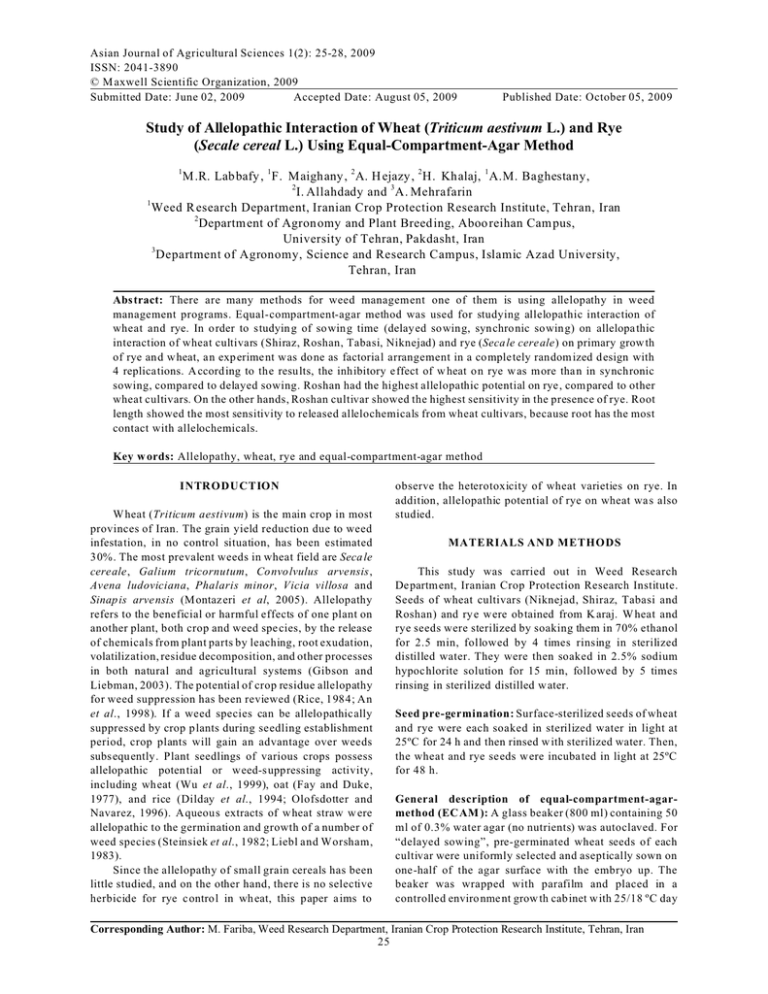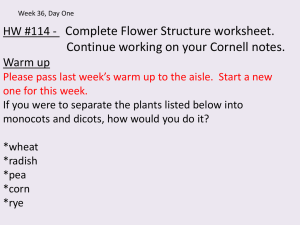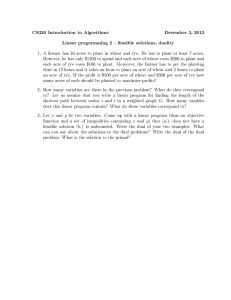Asian Journal of Agricultural Sciences 1(2): 25-28, 2009 ISSN: 2041-3890
advertisement

Asian Journal of Agricultural Sciences 1(2): 25-28, 2009 ISSN: 2041-3890 © M axwell Scientific Organization, 2009 Submitted Date: June 02, 2009 Accepted Date: August 05, 2009 Published Date: October 05, 2009 Study of Allelopathic Interaction of Wheat (Triticum aestivum L.) and Rye (Secale cereal L.) Using Equal-Compartment-Agar Method 1 M.R. Lab bafy , 1 F. Maighany, 2 A. H ejazy , 2 H. Khalaj, 1 A.M. Baghestany, 2 I. Allahdady and 3 A. Mehrafarin 1 Weed R esearch Department, Iranian Crop Protection Research Institute, Tehran, Iran 2 Department of Agron omy and Plant Breeding, Aboo reihan Cam pus, University of Tehran, Pakdasht, Iran 3 Department of Agronomy, Science and Research Campus, Islamic Azad University, Tehran, Iran Abstract: There are many methods for weed management one of them is using allelopathy in weed management programs. Equal-compartment-agar method was used for studying allelopathic interaction of wheat and rye. In order to studyin g of sowing time (delayed sowing, synchronic sowing) on allelopa thic interaction of wheat cultivars (Shiraz, Roshan, Tabasi, Niknejad) and rye (Seca le cere ale) on primary grow th of rye and wheat, an exp eriment was done as factorial arrangement in a completely random ized design with 4 replications. A ccord ing to the results, the inhibitory effect of w heat on rye w as more than in synchronic sowing, compared to delayed sowing. Roshan had the highest allelopathic potential on rye , compared to other wheat cultivars. On the other hands, Roshan cultivar showed the highest sensitivity in the presence of rye. Root length showed the most sensitivity to released allelochemicals from wheat cultivars, because root has the most contact with allelochemicals. Key w ords: Allelopathy, wheat, rye and equal-compartment-agar method INTRODUCTION W heat (Triticum aestivum) is the main crop in most provinces of Iran. The grain yield reduction due to weed infestation, in no control situation, has been estimated 30%. The most prevalent weeds in wheat field are Seca le cereale, Galium tricornutum, Convolvulus arvensis, Avena ludoviciana, Phalaris minor, Vicia villosa and Sinap is arvensis (Montaz eri et al, 2005). Allelopathy refers to the beneficial or harmful effects of one plant on another plant, both crop and weed spe cies, by the release of chemicals from plant parts by leaching, root exudation, volatilization, residue decomposition, and other processes in both natural and agricultural systems (Gibson and Liebman, 2003). The potential of crop residue allelopathy for weed suppression has been reviewed (Rice, 1984; An et al., 1998). If a weed species can be allelo pathically suppressed by crop plants during seedling establishment period, crop plants will gain an advantage over weeds subsequently. Plant seedlings of various crops possess allelopathic poten tial or weed-suppressing activity, including wheat (Wu et al., 1999), oat (Fay and Duke, 1977), and rice (Dilday et al., 1994; Olofsdotter and Navarez, 1996). A queou s extracts of wheat straw w ere allelopathic to the germination and growth of a number of weed species (Steinsiek et al., 1982; Liebl and Worsham, 1983). Since the allelopathy of small grain cereals has been little studied, and on the other hand, there is no selective herbicide for rye control in wh eat, this paper aims to observe the heterotoxicity of wheat varieties on rye. In addition, allelopathic potential of rye on wheat wa s also studied. MATERIALS AND METHODS This study was carried out in Weed Research Departm ent, Iranian Crop Protection Research Institute. Seeds of wheat cultivars (Niknejad, Shiraz, Tabasi and Roshan) and ry e were ob tained from K araj. W heat and rye seeds were sterilized by soaking them in 70% ethanol for 2.5 min, followed by 4 times rinsing in sterilized distilled water. They were then soaked in 2.5% sodium hypoc hlorite solution for 15 min, followed by 5 times rinsing in sterilized distilled w ater. Seed pre-germination: Surface-sterilized seeds of wheat and rye were each soaked in sterilized water in light at 25ºC for 24 h and then rinsed w ith sterilized water. Then, the wheat and rye seeds w ere incubated in light at 25ºC for 48 h. General description of equal-compartment-agarmethod (EC AM ): A glass beaker (800 ml) containing 50 ml of 0.3% water agar (no nutrients) was autoclaved. For “delayed sowing”, pre-germinated wheat seeds of each cultivar were uniformly selected and aseptically sown on one-half of the agar surface with the embryo up. The beaker was wrapped with parafilm and placed in a controlled enviro nme nt grow th cabinet w ith 25/18 ºC day Corresponding Author: M. Fariba, Weed Research Department, Iranian Crop Protection Research Institute, Tehran, Iran 25 Asian J. Agric. Sci., 1(2): 25-28, 2009 and night temperature, respectively; 13/11 h light/dark period. After g rowth of w heat se edling s for 7 days, 16 pre-germinated seeds of rye were aseptically sown on the other half of the agar surface. After that the beaker w ere again wrapped with parafilm and placed back in the grow th cabinet for 10 days. For “same-time” sowing, 16 pre-germinated wheat seeds were sown on on e-half of the agar surface and the 16 pre-germinated rye seeds w ere simultaneously sown on the other half of the agar surface. Rye and wheat seedlings were harvested for measurement after 10 days of growth. The growth of wheat and rye alone served as control. For “delayed sowing ”, 16 pre-germinated seeds of wheat were sown 7 days prior to the sowing of 16 pregerminated rye seeds in the beaker pre-filled with 30 mL of 0.3% water agar. For “same-time sowing”, 16 pregerminated wheat seeds were sown on one-half of the agar surface and 16 pre-germina ted rye seeds were simultaneously sown on the other half of the agar surface. Rye and wheat seedlings w ere harvested for measurement after 10 days of growth (Wu et al., 2000). There were no significant differences between the sametime sowing and the control, indica ting that allelochemical did not accumulate when wheat and rye seeds were sown at the same time. Therefore, rye root grow th was completely affected by wheat seedlings during 10 da ys of co-growth. Altho ugh delayed-so wing technique had a significant effect on rye root growth, there were no significant differences between the treatments on rye shoot growth. Rye dry weight: The effect of sowing time and wheat cultivar were not significant on ry e root, shoot, and whole plant dry weight (Table 1). This result disagrees with the findings of Olfsdotter and Navarez (1996) and Olfsdotter et al. (1999). Cheema et al. (1988) reported that wheat straw aqueous extract caused 15!20% inhibition of seed germ ination of cotton, but stimulated shoot and root growth and dry matter production. Allelopathic potential of rye on wheat Wh eat length: W heat len gth ch ange was sign ificantly depended on w heat cultivar an d sow ing time. Roshan cultivar showed the highe st sensitivity in the presence of rye (Table 2). Rye produces several compounds in its root exudates that appa rently inhibit growth of crops as wheat (Sattell et al. 1998). Pre-germinated wheat seeds with delayed sowing showed maximum inhibition in shoot length, compared to the control. There were no significant differences between different sowing times and the control (Table 2). W heat root length had the significant correlation with rye root length (r = 0.381 × ) and dry weight (r = 0.360× ). Wheat shoot length was significant correlated with ry e whole plant (r = !0.529× × ) and shoo t length (r = !0.610 × × ) (Table 3). Alam et al. (1990) demon strated that aqueous extract of fresh leaves of purple nutsedge significantly reduced seed germination, shoot and root lengths of wheat. Statistical analysis: This experiment was established in a factorial design, completely randomized with three replications. Four wheat cultivars (Niknejad, Shiraz, Tabasi and Roshan) and two sowing methods (delayed and same-time sowing) of rye were the experimental treatments. The data were subjected to analysis of variance using the statistical program of SAS Version 9.1. The mean differences were adjudged using Duncan Multiple Ran ge Test. Percentage inhibition of rye and wheat was calculated as treatment × 100/ control (Wu et al., 2000 ). RESULTS and DISCUSSION Allelopathic potential of wheat on rye Rye length: Means comparison showed that Roshan cultivar caused the highe st inhibition of whole and root length of rye. However, this cultivar did not show significant difference w ith the other wheat cultivars (Table 1). Some authors (e.g. Wu et al., 1998a, 1998b, and 2000; Li et al., 2000 ; Perez, 1990; Olofsdotter and Navarez, 1996; Guenzi et al., 1967; He et al., 2004; Dilday et al., 1992) reported variation in allelopathic potential among crop cultivars. Spruell (1984) reported that five wheat accessions produced root exudates inhibited the root grow th of the receiver plant that. Pre-germinated wheat seeds with same-time sowing with rye, caused maximum inhibition of rye length, compared to the control (Table 1). This resu lt is in disagreement with Wu et al. (2000) who concluded that pre-germinated wheat seeds that sown a week earlier than ryegrass, significantly inhibited ryegrass root elongation, compared to the same-time sowing, and the control. Pregerminated wheat seeds sown a week earlier than rye significa ntly inhibited rye root elongation, in comparison with the same-time sowing and the control (Table 1). Wh eat dry w eight: Sowing time and wheat cultivar had no significant effect on wheat root, shoot, and total dry weight (Table 2). Wheat total dry weight had the significant correlation (r = 0.366 × ) with rye total dry weight. Wheat root dry weight had significant correlation (r = 0.340 × ) with rye total dry weight (Table 3). H ussain and Abidi (1991) hav e repo rted that Lolium multiflorum, Sorghum almum, Cynodon dactylon, Imperata cylindrical caused reduction in seed germ ination, seedling gro wth and shoot and root dry weight of various crop p lants under laboratory and field cond itions. According to Belz and Hurle (2004), wheat root length had the high est sensitivity to allelochemicals. Therefore, root length m ay be a key param eter to verify allelopathic strength of different wheat varieties. The higher inhibition of roots com pared with shoots may be due to their more intimate contact with the treated filter paper. Results of this study are in agreement with those of Al Ham di et al. (2001 ), Inderjit et al. (2001), and L in et al. (2000) who found that root length is more affected than shoot growth. 26 Asian J. Agric. Sci., 1(2): 25-28, 2009 Table 1: M ean com paris on o f allelo path ic activ ity of w hea t seed lings and rye tim e so win g on rye (% con trol) Ry e len gth Rye dry weight -----------------------------------------------------------------------------------------------------------------------whole roo t sho ot wh ole root sho ot R y e s ow i ng ti me Control 100 a 100 a 100 a 100 a 100 a 100 a Delayed sowing 88.88 b 75.69 b 101.27 a 99.77 a 93.33 a 103.81 a Same time sowing 79.40 c 75.26 b 85.86 b 91.87 a 79.94 a 100.98 a Wh eat cultivar Control 100 a 100 a 100 a 100 a 100 a 100 a Niknejad 83.53 b 74.25 b 92.77 a 94.22 a 91.34 a 96.49 a Roshan 83.41 b 69.35 b 94.46 a 88.03 a 75.39 a 95.85 a Shiraz 86.01 b 82.17 b 92.01 a 103.00 a 92.48 a 114.45 a Tabasi 83.73 b 76.19 b 94.91 a 97.92 a 86.65 a 103.47 a M e a ns w it h t he sa m e l et te r i n e ac h co lu m n ar e n o t s ig n if ic an tl y d if fe re n t a t p ro b ab il it y l ev e l o f 5 % u si ng D M R T Table 2: M ean com paris on o f allelo path ic activ ity of ry e see dling s an d rye time s ow ing o n w hea t (% con trol) W hea t leng th Wheat dry weight ----------------------------------------------------------------------------------------------------------------------------wh ole roo t sho ot wh ole roo t sho ot R y e s ow i ng ti me Control 100 a 100 a 100 ab 100 a 100 a 100 a Delayed sowing 92.84 a 90.11 a 92.10 b 115.92 a 141.34 a 107.65 a Same time sowing 98.15 a 94.23 a 109.88 a 87.15 a 83.61 a 103.71 a Wh eat cultivar Control 100 a 100 a 100 a 100 a 100 a 100 a Niknejad 99.34 a 95.71 a 101.75 a 88.51 a 97.66 a 99.81 a Roshan 88.13 b 80.29 b 102.49 a 94.41 a 78.37 a 103.46 a Shiraz 94.28 ab 91.79 ab 97.36 a 132.04 a 115.63 a 115.75 a Tabasi 99.15 a 99.34 a 102.08 a 94.09 a 102.74 a 104.68 a M e a ns w it h t he sa m e l et te r i n e ac h co lu m n ar e n o t s ig n if ic an tl y d if fe re n t a t p ro b ab il it y l ev e l o f 5 % u si ng D M R T Table 3: Co rrelatio n be twe en w hea t and rye tra its whole plant root shoot leng th leng th leng th Rye wh ole p lant len gth 0.012 n s 0.289 n s !0.529 × × roo t leng th 0.233 n s 0.381 × !0.296 n s sho ot len gth !0.196 n s 0.131 n s !0.610 × × whole plant dry weight 0.177 n s 0.306 n s !0.026 n s root dry weight 0.202 n s 0.360 × !0.173 n s shoot dry weight !0.116 n s 0.157 n s 0.048 n s ns, × and ×× : not s ignif ican t, sign ifican t at pro bab ility leve ls 5% and 1% , respe ctive ly Rye seed sowing was delayed 1 week after seed sowing of donor wheat, thereby providing a short period of root establishment and the release of allelochemicals into the agar medium before /or durin g the growth of rye. The preaccumulation of the released allelochemicals prior to rye seed sowing, enables immediate allelopathic action once rye is sown. Delayed sowing produced much stronger inhibition than the same-time sowing on rye roo t grow th (Table 1). The substantial variations in allelopa thic potential of wheat accessions offer a sufficient genetic pool to select novel geno types and to transfer this allelop athic trait into mode rn cultivars for weed suppression. Further research is needed to determine the genetic control of crop allelopathic activity before any breeding programs can be initiated to dev elop crop cu ltivars w ith allelopathic potential. Further field screening is always advisable to substantiate laboratory results. whole plant dry w eigh t 0.195 n s 0.132 n s 0.106 n s 0.291 n s 0.297 n s !0.073 n s root dry we ight 0.211 n s 0.178 n s 0.096 n s 0.340 × 0.322 n s !0.078 n s s h o ot d ry weight !0.232 n s !0.221 n s !0.189 n s 0.011 n s 0.075 n s 0.001 n s alleloath ic potential on rye, compared to other wheat cultivars. On the other hands, Roshan cultivar showed the highest sensitivity in the presence of rye. Roo t length showed the mo st sensitivity to relea sed allelochemicals from wheat cultivars, because root has the most contact with allelochemicals. REFERENCES Al Hamdi, B., Inderjit, M. Olofsdotter and J.C. Streibig, 2001. Laboratory Bioassay for Phytotoxicity: An Example from W heat S traw. Agron. J., 93 : 43-48 . Alam, S.M ., A.R . Azm i and S .A. A li, 1990. Effect of purple nutsedge (Cyperus rotundus L.) leaf extract on germination and seedling growth of wheat. Pak. J. Sci. and Ind. Res., pp: 33-235. An M., J. Pratley and T. Haig, 1998. Allelopathy: from Concept to Reality, In: Proceedings, 9th Australian Agronomy Conference. D.L. Michalk and J.E. Pratley (Eds.). Wagga W agga, Australia., pp: 563-566. Belz, R.G . and K . Hurle, 2004. A novel laboratory screening bioassay for crop seedling Allelopathy. J. Chemical Ecol., 30: 175-198. CONCLUSION According to the results, the inhibitory effect of wheat on rye was more than in synchronic sowing, compared to delayed sowin g. Roshan had the highest 27 Asian J. Agric. Sci., 1(2): 25-28, 2009 Cheema, Z.A., S. Ahmed, S. Majeed and N. Ahmed, 1988. Allelopathic effects o f wheat (Triticum aestivum L.) straw on germination and seedling grow th of two weed species and cotton. J. W eed S ci. Res., 1: 118-122. Dilday, R.H., R.E. Frans, N. Semidey, R.J. Smith and L.R. Olive r, 1992 . W eed control with crop allelopathy. Arkansas Farm Res., 41: 14-15. Dilday, R.H., J. Lin and W. Yan, 1994. Identification of allelopathy in the USDA -ARS rice germplasm collection. A ust. J. Ex p. Agric., 34: 907-910. Fay, P.K. and W.B. Duke, 1977. An assessment of allelopathic potential in Avena germplasm. W eed Sci., 25: 224-228. Gibson, L. and M. Liebman, 2003. A Laboratory Exercise for Teaching Plant Interference and R elative G rowth Rate Concepts. Weed Technol., 17: 394-402. Guenzi, W .D., T.M. Mccalla a nd F.A. Norstadt, 1967. Presence and p ersistence of phytoto xic subtances in wheat, oat, corn and sorgh um re sidues. Ag ron. J., 59: 163-165. He, H.Q., L.H. Shen, Y.C. Guo, J.Y. Wang and W.X. Lin, 2004. Genetic diversity in allelopathic rice accessions (Oryza sativa L.). Proceedings of the 4 th International Crop Science C ongress. Hussain, F. and N. Abidi 1991. Allelopathy exhibited by Imperata cylindrica L. Beauv, 23: 15-25. Inderjit, M. Olofsdotter and J.C. Streibig, 2001. Wheat (Triticum aestivum) interference w ith seedling grow th of perennial ryegrass (Lolium perenne) of density and age. W eed T ecno l., 15: 807-812. Li, X.J., B.H. Li and D.Z. Lu, 2000. A preliminary study on allelopathic effect of wheat plant extracts on Digitaria ciliaris (L.) Scop. Weed Sci., 3: 4-6. Liebl, R.A. and A.D. Worsham, 1983. Inhibition of pitted morning glory (Ipom oea lacunose L.) and certain other weed species by phytotoxic components of wheat (Triticum aestivum L.) straw . J. Chem. E col., 9: 1027-1043. Lin, W .X., K .U. K im and D.H. Shin, 2000. Rice allelopathic poten tial and its m odes of action on Barnyardgrass (Echinochloa crue-galli). Allelopathy J., 7: 215 -224. Montazeri M., E. Zand and M.A. Baghestani, 2005. Weed and their control in wheat fields of Iran. Agricultural Education Press. Ololfsdotter, M., D. Navarez, M. Rebulanan and J.C. Streibig, 1999. Weed suppressing rice cultivars does allelopathy play a role? Weed Res., 39: 4441-4454. Olofsdotter, M. and D . Nav arez, 1996. Allelopathic rice for Echinoch loa crus-ga lli control, In: Proceedings, 2nd International Weed Control Congress. H. Brown, G .W . Cussans, M .D. D evine , S.O. Duke, C. Fernadez-Quintanilla, A. Helweg, R.E. Labrada, M. Landes, P. Kudsk, and J.C. Streibig, (Eds.). Copenhagen, Denmark, pp: 1175-1181. Perez, F.J., 1990. A llelopathic effects of hydroxamic acids from cereals on Avena sa tiva and A. fatua. Phytochemistry, 29: 773-776. Rice, E.L., 1984. Allelopathy, 2nd Edn. Academic Press, Orlando, Florida. Sattell, R., R. Dick, R. Karow, D. Kaufman, D. H emp hill, J. Luna and D. McG rath, 1998. Oregon Cover Crops: Cereal Rye (Secale cereale L.). http://exte nsion .orego nstate.e du/ca talog/h tml/ em/em8694. Spruell, J.A. 1984. Allelopathic potential of wheat accession. Dissertation Abstract Inern ationa l, B. Sci. Eng., pp: 45-1102. Steinsiek, J.W ., L.R. O liver and F.C . Collins, 1982. Allelopathic poten tial of wheat (Triticum aestivum) straw on selected w eed species. Weed Sci., 30: 495-497. W u, H., J. Pratley, D. Lemerle, T. Haig and B. Verbeek, 1998a. W heat allelopathic potential against a herbicide-resistant biotype of annual ryegrass. Proceedings of the Australian Agronomy Conference. W agga W agga, N SW . W u, H., J. Pratley, D. Lemerle, T. Haig and B. Verbeek, 1998b. Differential allelopathic potential among wheat accessions to annual ryegrass. Proceedings of the Australian Agronomy Conference. Wagga W agga, N SW . W u, H., J. Pratley, D. Lemerle and T. Haig, 1999. Crop cultivars with allelopathic capability. W eed R es., 39: 171-180. W u, H., J. Pratley, D. Lemerle and T. Haig, 2000. Laboratory screening for allelopathic potential of wheat (Triticum aestivum) accessions against annual ryegrass (Lolium rigidum). Agust. J. Ag ric. Res., 51: 259-66. 28







